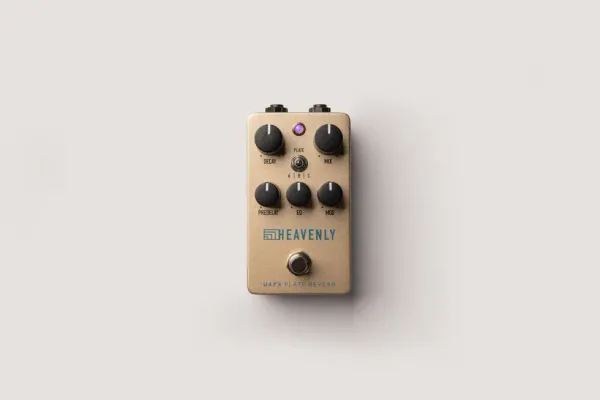It’s been just a few years since Universal Audio unleashed the first UAFX effects. These ARM-processor-driven stompboxes borrowed algorithms from powerful plugins designed for Universal Audio’s Apollo interfaces. The authenticity and functionality of the UAFX pedals is impressive. But as potent and brimming with tone-shaping options as they are, they are also a significant investment—clocking in at just under $400 for a single pedal.
Enter the 1176, Evermore, Heavenly, and Orion. These more compact and specialized UAFX stomps are based on the same algorithms that drive effects in their bigger cousins. But by using roughly half the processing power and focusing on emulation of a single effect, UA achieved more digestible prices ranging from $199 to $219. The 1776, Evermore, Heavenly, and Orion model the Universal Audio 1176 compressor, Lexicon 224 digital delay, EMT-140 plate reverb, and Maestro Echoplex EP-3, respectively. Practicality dictates that most of those effects will rarely see use outside of studio environments. So, it can be thrilling to experiment with these emulations in a guitar effects chain. They are captivating pedals capable of deep, rich, authentic sounds, and, in many cases, delightfully unexpected results.
1176 Compressor
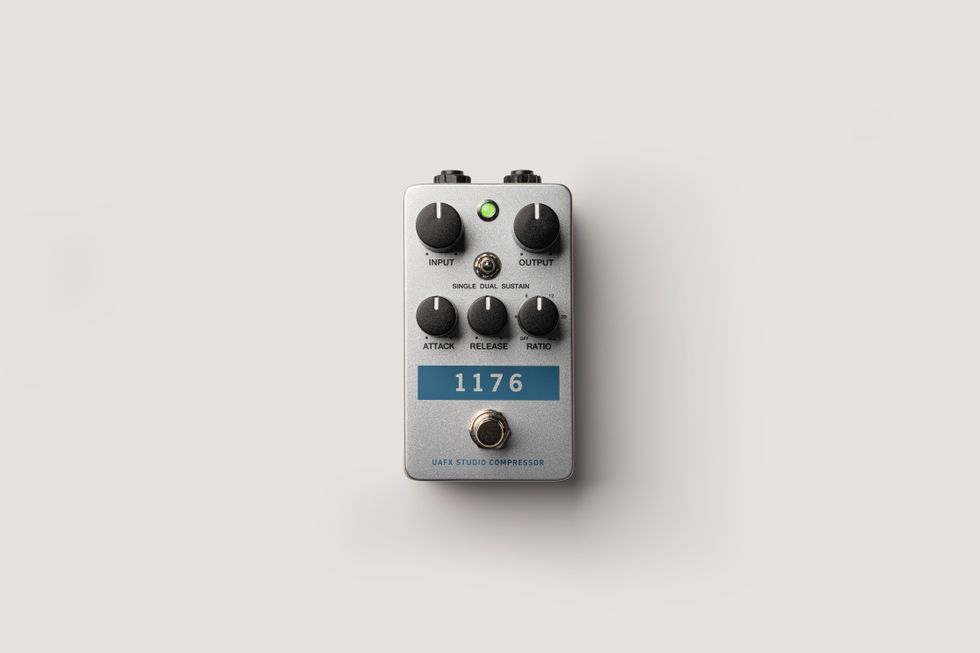
The simple, elegant, and timeless 1176 FET compressor is a pillar of Universal Audio’s success, past and present. In the studio, many engineers tend to use a few go-to 1176 settings that they tweak slightly depending on the context. But the 1176 is also an awesome blank slate for more creative use and abuse. That capacity is showcased especially well in the 1176 pedal.
Though the 1176 pedal includes a few bonus concessions to modern guitarists, like the useful parallel wet/dry mix switch, the control set effectively replicates the features on the hardware version. There are knobs for input and output level, attack and release controls, and a fifth knob that replicates the original’s push-button ratio presets, including the much-loved all-buttons-in setting. The last of these can be used to generate overdriven textures that often sound and feel different from amplifier or stompbox distortion, and the 1176’s knack for this kind of sweet-to-confrontational overdrive is among the reasons it works so well as a guitar effect. This design strength is highlighted by way of the pedal’s 3-way toggle switch. It moves between emulation of a single 1176, or two settings that emulate two 1176s in series. The dual mode models the 1176-in-series technique used by Jimmy Page and engineer Andy Johns—most famously on Led Zeppelin IV. The sustain mode, meanwhile, emulates the double-1176 method practiced by Little Feat’s Lowell George.
“The 1176’s knack for sweet-to-confrontational overdrive is among the reasons it works so well as a guitar effect.”
Of the two, the dual mode is the most aggressive, effectively turning the input level control into a gain factory that spans thick overdrive and fuzzy direct-to-desk tones. It’s an awesome alternative to fuzz pedals because it sounds so nasty at civilized output gain levels, lending flexibility in stage and studio settings. But it’s also a beautiful thickening agent at lower input gain levels, adding grit and body while retaining dynamic response. The sustain mode is even lovelier in these low-gain signal-thickening applications. It doesn’t have nearly as much fuzzy gain to give, but the overdrive is complex and lends a fluid cohesiveness to lead lines.
The 1176 also excels in the more conventional single mode, adding body, sparkle, and volume without obscuring a guitar’s essence. It works wonders with thin single-coils. In fact, I would venture that the 1176 does the job of a clean boost better than any clean boost ever could. That said, the single mode still delivers yummy overdrive tones when you switch to all-buttons-in mode and lean on the input gain.
If you suffer from lifeless amp tones at low stage volumes, the 1176 could be indispensable. Some players will balk at using a digital gain source in front of an amplifier. But open-minded players will be surprised at just how organic this pedal sounds. Just like the hardware version, the 1176 pedal is capable of minor acts of magic.Evermore Reverb
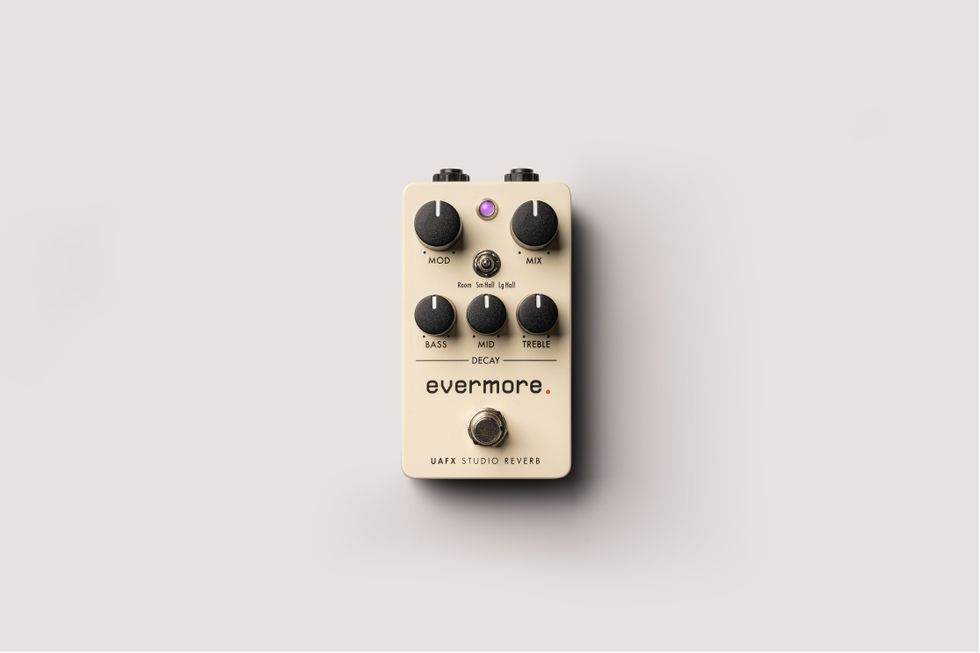
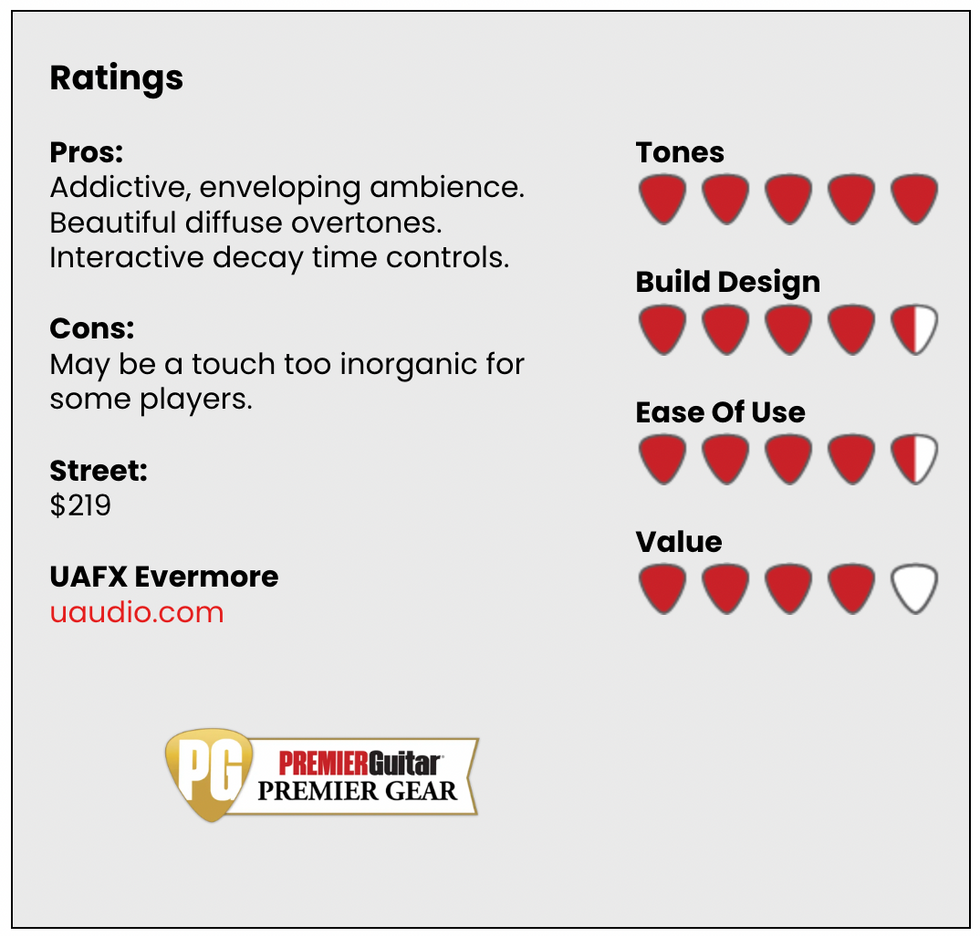
The Lexicon 224 had a profound effect on music in the 1980s. For many of us, its tones are burrowed in our subconscious. As much a mood as a tonality, the 224’s odd combination of icy, diffuse overtones and enveloping space was instrumental in shaping the atmospheres around Vangelis’ soundtrack for Blade Runner. And in the hands of production visionaries Brian Eno and Daniel Lanois, who helmed U2’s The Unforgettable Fire, it could sound both unsettling and deeply peaceful. The Lexicon’s ability to span so much emotional range and sound so alive is a feat, and the Evermore captures these elusive qualities masterfully.
Chances are good that if you’re curious about the Evermore, it’s because of the 224’s reputation as a primo ambiance machine. But the Evermore sounds great in down-to-Earth applications. Trebly room settings, for example, convincingly approximate spring reverb and bathroom-tile slapback. The small hall setting, too, is capable of modest-but-rich reverbs that sit nicely with distortion effects and add thickness and lively overtones to clean sounds.
“The Evermore sounds great in down-to-Earth applications.”
The Evermore’s most compelling effects, however, come via the pedal’s large hall setting. And it’s here that you grasp the vast potential of the pedal’s frequency-specific decay time controls. At a glance, you could mistake the bass, mid, and treble knobs on the Evermore for a simple EQ section. In reality, each of these controls governs the decay time for a given frequency range. This capability is a powerful and brilliant facet of the 224s design, and it shines in the Evermore, enabling painterly approaches to soundscaping that shake up preconceptions and stretch your imagination. One could spend days exploring the intricate ways the decay time controls interact with each other and with different instruments. But the way long bass and midrange decay times at high mix levels can generate haunting resonances, feedback, and airy, grainy harmonics within massive spaces is super-compelling, and hearty food for the ear and mind’s eye.
Heavenly Reverb
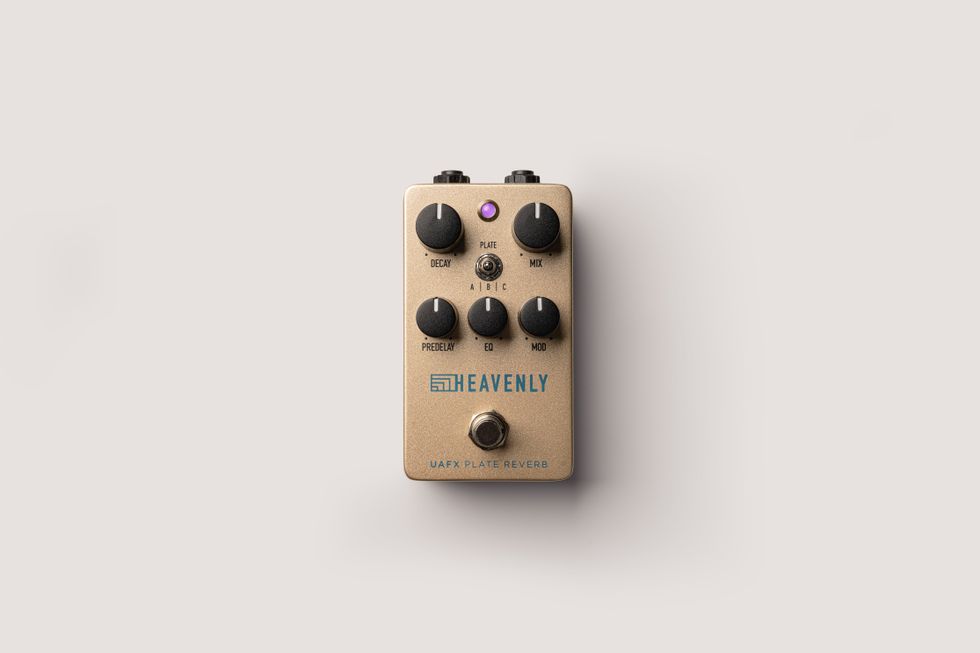
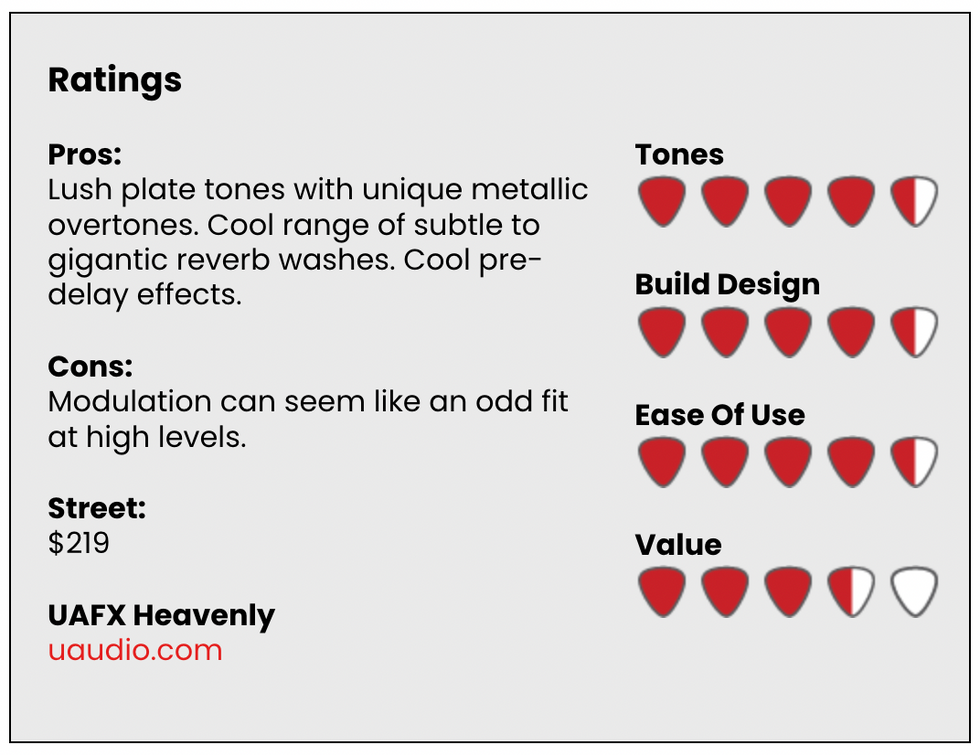
One of the great privileges of my musical life is having had the chance to record with an EMT 140 plate reverb and bathe in its transformative ambience. Capable of ranging from metallic and clanging to soft and ethereal, the wall-sized EMT 140 plate is unlike any other reverb. And though my favorite applications for the EMT 140 are recording vocals, piano, and acoustic guitar, there is no denying the wonders it works with electric guitar. The Heavenly, which has the good fortune to be derived from one of the finest Apollo plugins, makes it easy to experiment with marriages of electric guitar and EMT textures.
Of the four pedals reviewed here, the Heavenly is arguably the most straightforward, and just about anyone that has worked with a stompbox reverb before will be at ease after a quick peek at the instruction card. Ease of operation does not mean, however, that the Heavenly is less capable of complex reverb colors or interesting interrelationships between the controls. Heavenly features three basic reverb voices, selectable from the 3-position toggle. Position A is a vintage bright mode, B is a vintage dark voice, and C is the modern full position. The three voices can be further shaped by the simple EQ control. The pre-delay control, which governs the time that lapses before the onset of the reverb effect, opens up some of the most intriguing possibilities. Setting the reverb for a long decay, the mix just on the dry side of noon, and the pre-delay for a long lag creates a mysterious blend of strong fundamental note and a hazy reverb tail that hits with the percussive impact of a short delay. It sounds fantastic on spare, fingerpicked parts, arpeggios, and sharp staccato chords. While less conventional uses of EMT-style textures are intriguing, most players will probably be content to wade in the wash of traditional plate tones. Heavenly sounds beautiful in these environs. And even modest mix levels reveal a pretty, blooming decay that can sound both subdued and outside the familiar realm of less authentic plate-inspired reverbs.
“The pre-delay control opens up some of the most intriguing possibilities.”
The Heavenly’s EMT 140 simulation sometimes seems like an odd match for a guitar pedal, and not just because you’ve never seen anyone stick an 8-foot-long EMT 140 on a pedalboard. Perhaps because they sound as accurate as they do, there is a sort of post-production quality to the tones that can sound a bit out of place coming from an amplifier. And the chorus-y modulation, though lovely in some settings, can sound grafted on at times. For players unconditioned to hearing the sound of an EMT 140 blasting through studio monitors in the thick of a mix, however, the potential in these big, luxurious textures will feel considerable.
Orion Tape Echo

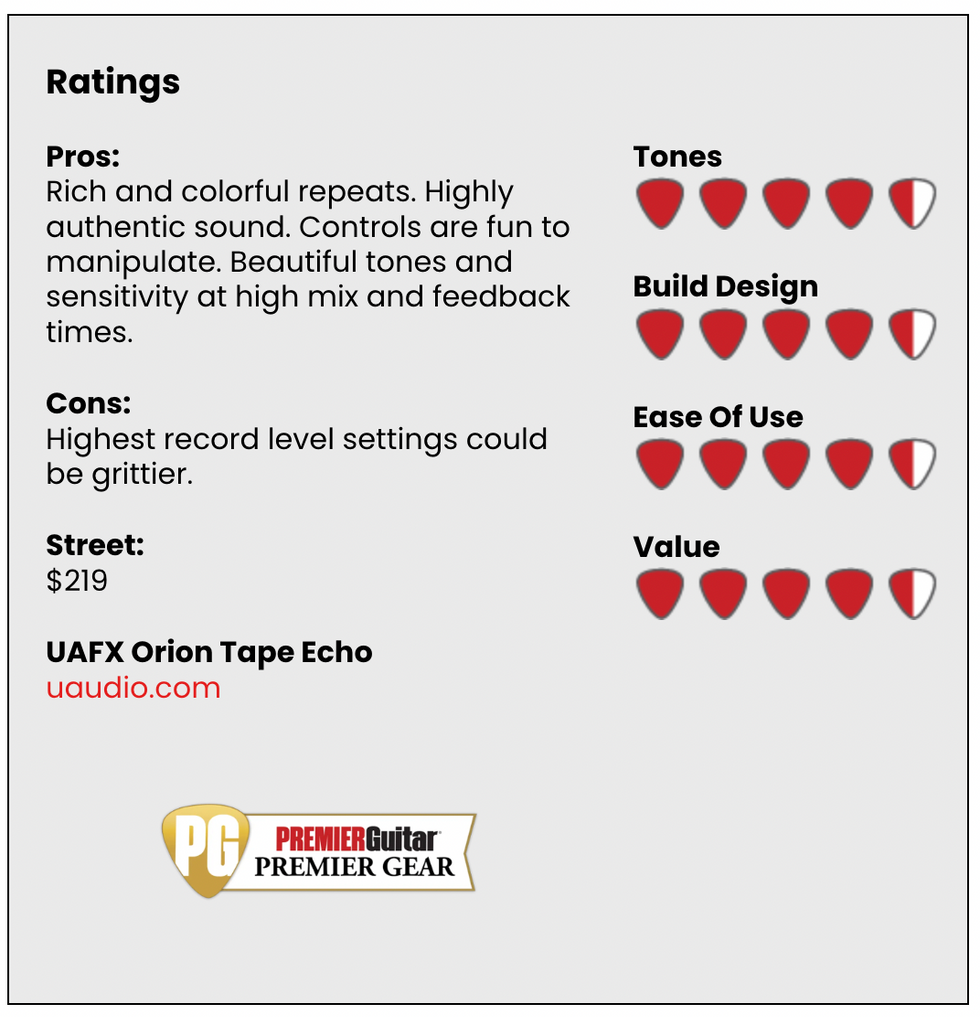
If I could only take one effect with me to space, or on some forced exile, it would almost certainly be my Maestro Echoplex EP-3. Like most of the great tape echoes, it is, by virtue of its quirky controls, an instrument all by itself. But above all things, the EP-3 is just plain fun. From the tape head slider to the smartly arranged echo level and sustain controls that facilitate oscillation effects, it is a box of pure musical joy. And just like any analog effect with such bountiful quirks and electro-mechanical idiosyncrasies, it can be a bear to reproduce in the digital stompbox realm. The Orion, however, does a more than admirable job of emulating the beautiful bits and the oddities that make up the EP-3’s weird and wonderful personality.
Four of Orion’s knobs—delay, mix, feedback, and control level—replicate those on an EP-3. Three additional controls help further shape the Orion’s performance envelope in subtle and more overt ways. The wonk knob controls virtual wow and flutter, and its intensity is regulated in large part by the tape age toggle, which selects from emulations of a very old, weathered tape, a less worn but well-used tape, and a fresh tape cartridge that Universal Audio designer James Santiago used for the first time to create the new tape setting. Additionally, a preamp switch on the pedal’s crown enables you to select whether the onboard preamp emulation remains on when the pedal is on in bypass mode or removed from the dry signal entirely. When it is on, it adds a mildly colorful boost that fattens the pedal’s output and blurs the space between repeats ever so slightly.
“The Orion’s mellowing haze between repeats sounds very authentic.”
The Orion comes pretty close to sounding like a real EP-3. It’s quieter, less dirty at high record levels, and the wow and flutter are less irregular. But the Orion’s mellowing haze between repeats sounds very authentic. It is also very discernibly not a bucket brigade or digital delay. The pedal sounds exceedingly pretty at high mix and feedback levels, especially when you use a light, feathered touch on chords or volume swells (which sound wonderfully spooky). Working the mix, feedback, and delay time controls at the threshold of oscillation is also a delight, made even more satisfying for the just-right resistance in the knobs. These out-there effects also yield some of the Orion’s more buried treats, like the simulated tape splice and a slight lag that you hear as you work the delay time control. At $219, the Orion has few peers, and most, save for Catalinbread’s Belle Epoch, are significantly more expensive. All told, it’s a relatively affordable path to approximating one of the most beloved and distinctive effects of all time.
